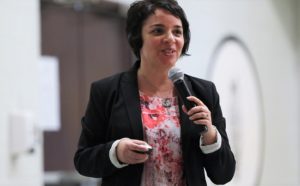Indigenous knowledge must come first

By Kelly Anne Smith
NIPISSING FIRST NATION—In the second of a three-part series, researcher Lisa Blenkinsop presents her findings to Nipissing First Nation. Her community research in the Fish-WIKS project with Nipissing First Nation is based on knowledge.
Fish-WIKS is looking for answers from the best of Indigenous and western knowledge to sustain fisheries and the people who thrive from them.
Lisa Blenkinsop said information gathering in Nipissing First Nation showed connections to the fishery because the community is so involved in fisheries.
“The fisheries knowledge aspect came out a lot in the workshops that were part of the research.”
Blenkinsop’s focus was on knowledge.
“I was looking at how did intergenerational knowledge transfer or happen for Elders? And how does it happen for youth now? Do they get the same knowledge? And of course they don’t. It’s very different.”
“With the Elders, it was pretty phenomenal that a lot of them were older and their upbringings were much more traditional than I had expected—living in the bush during hunting season and farming with gardens. Their backgrounds were very different than those of the high school students that were part of the research as well.”
Here is the key to the disconnection of knowledge between generations, exclaims Blenkinsop.
“The Elders spent so much more time with their Elders, with their grandparents, with community members, and their parents. Every day they were learning their knowledge. They were speaking in Anishinaabemowin. That learning was part of their life.”
Blenkinsop says life is quite different for the youth of Nipissing First Nation.
“They don’t live in multi-generational households. They see their grandparents for special occasions. They don’t learn the language at home. Any connection they have to culture and language would be much more formal – ceremonies in the community or going to language class.”
“For the youth – Nipissing has a school – they have to decide, do they go to the school where they are learning their culture or do they go to one of the many different schools in Sturgeon Falls or North Bay, which most of them do. It is that disconnect between the generations which has stopped the knowledge from being shared.”
“The community is working really hard at putting those mechanisms back in place.”
Blenkinsop refers to Nipissing First Nation Cultural Manager Glenna Beaucage who working to develop The Culture and Language Strategic Plan. As the community decides best on how to re-establish language and culture, Blenkinsop points to the many positives already in place, such as language classes and Nbisiing Secondary School.
“It was really important to many community members to re-establish their culture and language.”
Blenkinsop conducted workshops which were recorded and shared with the community.
“There’s twelve hours of stories. The stories that the Elders told were so amazing. Their lives of when they were growing up and their connection to their language and their community are great.”
Nipissing First Nation’s creation of The Culture and Language Strategic Plan is a model for other communities to use says Blenkinsop.
“Indigenous knowledge is contextual and always evolving. How does it evolve? How do communities evolve to use technology, in some ways it’s controversial, to record stories? How do you preserve those stories? How do you use technology and other means, to re-establish that link, in ways that work for youth today?”
“Building relationships – that is really at the root, I found, of everything in my research was that relational learning. Everything is related- that’s all my relations. The importance of building relationships was very key in the community and for me as well.”
Blenkinsop says Nipissing First Nation has been able to take the positives and strengths of the western society and their own worldview and incorporate them into the Memorandum of Understanding (MOU).
“As part of the MOU, there’s cultural training for Ministry of Natural Resources staff. That is so important to understand any source of conflict between cultures. And to understand those worldviews, it’s critical. If the conservation officer understands where the community is coming from, there will be more compassion and understanding what they are dealing with.”
“Indigenous knowledge comes first, and then settler knowledge can get woven in. It has always been the other way around.”
Blenkinsop calls herself a settler Canadian and credits her brother with getting involved with Fish-WIKS.
“My brother is a Sixties Scoop Survivor. He is Anishinabe from Big Grassy First Nation. Indigenous identity has always been a part of my life. Seeing his huge and terrible troubles with colonialism has really influenced my life.”
Highest Nipissing First Nation (NFN) community populations are found in Beaucage Subdivision; Beaucage Village; Duchesnay; Garden Village; and Jocko Point. The NFN Lands Department list includes Meadowside, Mosquito Creek, Paradise Point (in Jocko Point), Serenity Lane, Veteran’s Lane and Yellek.


